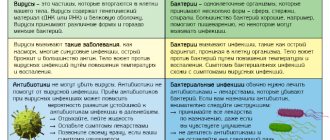Antibiotics are used for infectious diseases caused by bacteria. They either destroy pathogenic microorganisms (bactericidal drugs) or limit their proliferation (bacteriostatic antibiotics), leaving the immune system to fight the infection itself.
In order for antibiotics to be effective, you must follow certain rules for taking them.
Antibiotics are prescribed by the doctor
Only a specialist can choose the appropriate drug from the huge number of items produced by the pharmaceutical industry. When prescribing a medicine, the doctor takes into account the disease, age and condition of the patient, the presence of concomitant pathologies, and the side effects of the drug. And if the doctor prescribed you an antibiotic, you need to take it.
Today there are two extreme points of view regarding antibiotics. Some consider them an absolute evil and refuse treatment. Others, on the contrary, are ready to swallow antibiotics for any cold. Both are wrong.
Yes, indeed, this group of drugs is far from harmless, and while killing pathogenic microbes, they also destroy beneficial microflora. But in case of severe infections, you cannot do without them. By refusing to take the pills, you risk ending up in a hospital, where you will be given the same antibiotics, but by injection or through an IV, and in much larger doses.
Those who try to treat a runny nose with antibiotics (and this is a viral infection that antibiotics have no effect on) will not get rid of the disease, but they may suffer from the side effects of the drug.
BSMU is a leading Belarusian medical university
May 11, 2021
Humanity invented antibiotics more than nine decades ago. And this is considered one of the significant discoveries in world history. However, in recent years, antibacterial drugs have increasingly become the subject of debate. Some of their participants adhere to the point of view that antibiotics are necessary medicines that help resist diseases. Other experts are convinced that taking antibacterial drugs is dangerous, because they themselves cause serious problems in the human body. So what are antibiotics – “friends” or “enemies”? Answers to this and some other questions regarding antibacterial drugs were given by the head of the department of military field surgery of the military medical faculty at the Belarusian State Medical University, candidate of medical sciences, associate professor, colonel of the medical service Dmitry Aleksandrovich Klyuiko.
– Dmitry Alexandrovich, please tell us what antibiotics are? What diseases are they used to treat?
– Translated into Russian, the word “antibiotic” (Latin anti “against” and Greek bios “life”) means “against life.” In fact, antibacterial drugs were created to inhibit the reproduction and growth of microorganisms, which are pathogenic bacteria. Nowadays, antibacterial drugs defeat serious diseases, many of which were previously considered incurable, such as pneumonia, tuberculosis, gastrointestinal infections, postoperative complications and some others.
However, antibiotics are absolutely ineffective against viral infections. For example, they will not help with the flu, ARVI, hepatitis A, B and C. However, if the flu leads to complications, including pneumonia, the doctor will prescribe an antibacterial drug to treat the bacterial infection associated with the viral disease.
– How many antibiotics are there in the world now?
– Today, several thousand different natural and synthetic substances are known that are used as antibiotics. They are combined into 17 classes, and each of them acts on a specific type of pathogen. Thus, penicillin, the first antibiotic, discovered in 1928 by British microbiologist Alexander Fleming, belongs to the class of beta-lactam antibiotics. Of the known antibacterial drugs, only a small part is used - no more than 5%, since most of the previously discovered antibacterial drugs have become useless due to antibiotic resistance.
– What are the different methods of administering antibacterial drugs?
– There are intravenous, intramuscular and enteral methods of administering antibiotics. The dosage, number of doses and bioavailability of antibacterial drugs depend on them accordingly. Each of these methods has its own advantages. So, the drug that enters the body intravenously will act most quickly, then intramuscularly, and enterally the slowest.
– What rules should be followed when taking antibacterial drugs?
– Since any antibiotic is a toxic substance, the most important thing is to ensure that its use brings maximum benefit and minimum harm. To do this, regardless of the type of antibacterial drugs prescribed, it is advisable to follow the following recommendations.
The first rule is that antibacterial drugs must be used strictly as prescribed and only for diseases where they are truly necessary. Even if this is a “cover-up” for possible complications, it must be adequate according to all principles of rationality - a certain dosage, frequency of administration, etc. Otherwise, nothing good should be expected except harm to the body.
Antibacterial drugs as a preventive measure are prescribed to patients with reduced immunity, in the presence of high fever, “bad” cough and similar symptoms, as well as to those who are undergoing treatment in a hospital setting, where there is a bacterial environment (nosocomial infection). If the patient is treated at home and uses rational anti-inflammatory therapy, which brings positive results, there is no need to “hide behind” antibiotics.
The second rule is that even if the condition improves immediately, the course of treatment must be brought to its logical conclusion. Because bacteria that are not completely suppressed form resistance to the antibiotic, and further treatment will be ineffective. The minimum period of treatment with an antibacterial drug is seven days.
The third rule is that the prescribed dosage must be adequate. Sometimes, in order to avoid side effects, the fight against the disease begins with a small dosage of antibacterial drugs. As a result, it turns out to be ineffective, and soon the bacteria stop responding to the drug and even the class to which it belongs.
The fourth rule is that antibiotics should be prescribed according to status. That is, if a patient has a severe infection, he must take a potent antibacterial drug, and if it is weak, then a medicine of appropriate strength. And in no case is it the other way around. In general, antibiotics are prescribed empirically - the doctor assumes that the infection will be affected by the prescribed drug.
The fifth rule is that antibiotics “don’t work” when there is a focus of infection in the body. Therefore, first it is eliminated, and only then antibacterial drugs are prescribed.
The result of treatment will also be zero if the patient’s body lacks the protein that carries the antibiotic components. The only way in this case is to replenish protein reserves.
The sixth rule is that the same antibiotic can be produced in low and high dosages. This means you should be careful and purchase it in doses strictly prescribed by your doctor.
Antibiotic treatment is effective only if it is taken correctly and all doctor’s instructions are followed. Under no circumstances should you prescribe antibacterial drugs yourself, so as not to cause even more harm.
– What is resistance and why does it occur?
– Resistance is the resistance of microorganisms to antibiotics. The fact is that microorganisms tend to evolve. And sooner or later, as a result of mutations, they adapt to the action of one or another antibiotic, which becomes harmless to them. Medical experts are currently concerned that pathogenic bacteria are adapting to antibiotics much faster than new drugs are being invented.
Many doctors talk about the danger of mass use of antibiotics, because due to the rapid pace of bacterial development, there is a threat of the emergence of resistant flora that cannot be resisted by modern antibacterial drugs. The first antibiotics (penicillin, biomycin) were of natural origin, they were obtained from mold fungi. They had a narrow spectrum of action and did not cause damage to the body, because its microflora was already adapted to the substances they contained.
Antibiotics of the new generation are synthetic. Having a wide spectrum of action, they kill almost all bacteria, including beneficial intestinal microflora. At the same time, pathogenic microflora very quickly adapts to such drugs - in almost 2-3 months, new strains appear that are resistant to these antibacterial agents. The natural microflora, which is an integral part of our immunity, is restored much more slowly. As a result, immunity “falls” sharply, and many dangerous pathogens can easily penetrate the body, as they say, with all the ensuing consequences.
The main responsibility lies with the patients. If a person took an antibiotic exactly as prescribed by the doctor until complete recovery, there would be no pathogens left in his body. Unfortunately, patients often “drink” antibiotics without a doctor’s instructions, in insufficient concentrations, and do not complete the course of treatment, so some pathogens survive such therapy, and their carrier remains infectious to others, even if they temporarily do not feel unwell. Doctors also have a certain share of the blame, as they sometimes prescribe antibacterial drugs unnecessarily. As a result, this leads to an increase in the number of microorganisms that cannot be neutralized by simple antibiotics.
– How can we minimize the negative impact of antibiotics on the human body?
– Antibiotics are designed to aggressively interfere with the life of microorganisms. Targeted accuracy of the effects of drugs on pathogenic bacteria has not yet been achieved, although scientists have been working on this for many years. Therefore, the use of antimicrobial agents is accompanied by side effects and can adversely affect the patient’s health and well-being. In this regard, before using the medicine, it is mandatory to study the instructions. If you have diseases listed in the list of contraindications, you should consult your doctor for advice.
You should not take the medicine on an empty stomach, so as not to increase irritation of the mucous membrane. Be sure to take antibiotics with water. In this case, you should exclude the use of alcohol, absorbent and blood thinning drugs.
To maintain normal intestinal microflora, it is recommended to take probiotics, preparations with lactobacilli, immunomodulators and vitamin complexes.
The use of antibiotics in our time is a kind of arms race, when bacteria dictate their conditions, and medicine is forced to adapt to them and offer antibacterial drugs that meet these requirements. The consequences of the use of such drugs are global in nature when a particular antibiotic ceases to affect the population. And with each generation, antimicrobial drugs become more toxic. In turn, the bacteria “waste no time” and adapt to the new enemy, showing even greater aggressiveness. The individual nature of the consequences of using antibiotics is that they have a negative impact on the functioning of internal organs. That is why in our country, as well as throughout the civilized world, antibacterial drugs are mostly sold in pharmacies only with a doctor’s prescription.
To avoid all kinds of diseases, you should strengthen your immune system by adopting a healthy lifestyle, including proper nutrition, exercise, hardening and much more. Antibiotics should be the last line of treatment if something happens.
Interviewed by Oksana Kurbeko, press secretary, photo from the personal archive of Dmitry Klyuiko and open sources
Share
Antibiotics must be taken strictly according to the schedule
Your doctor will tell you your dosage regimen. In addition, each drug has instructions that describe in detail when (morning, evening, before/after meals) and how many times a day the medicine should be taken. Antibiotics should be taken at the same time, and the intervals between doses should be equal. Usually the drug is taken 1-2-3-4 times a day, which means the intervals should be 24-12-8-6 hours. This is the period of time the pill works, then its effect ends, and if you miss the time of taking it, the bacteria will begin to multiply intensively, poisoning the body. In addition, microorganisms may develop resistance to this antibiotic.
Antibiotics for viral diseases
Often, general practitioners prescribe antibiotics to their patients, such as Cetrin, at the first symptoms of the disease. They are taken in combination with antiallergic, antiviral and anti-cold medications. The question arises: “Do experts really not see the difference between a viral and bacterial infection?” Naturally, they see it. It is also clear to everyone that few people, after receiving a diagnosis of ARVI, will remain in bed and undergo treatment.
In reality, complications should not appear. A healthy body with a strong immune system is able to overcome seasonal diseases in 4-6 days. The patient must provide the body with all the necessary conditions: maintain bed rest, drink as much water as possible, ventilate the room.
In reality, few people follow these rules. Many continue to go to work and do household chores, which is why the illness can drag on for several weeks. As a result, active proliferation of microbes occurs in the body. Antibiotics then help prevent the spread of bacteria.
You need to complete the full course of treatment
As a rule, if the antibiotic is effective, improvement occurs on the 3rd day of treatment. But this does not mean recovery. You should not interrupt the course, even if you feel much better. By stopping taking the medicine ahead of time, firstly, you will soon feel worse, since not all bacteria have been destroyed, and secondly, your bacteria will become resistant to this antibiotic and in the future it will no longer act on them. You will get the same result if, after feeling an improvement in your condition, you reduce the dose of the drug.
Are probiotics necessary?
Antibiotics kill bacteria, but they do not distinguish good microorganisms from bad ones. These powerful drugs destroy vital bacteria necessary for the normal functioning of the digestive and immune systems. The best way to replenish losses is to consume probiotics, which contain live bacteria that normally inhabit the intestines.
Probiotics are prescribed during and after a course of antibiotics to restore intestinal microflora and, therefore, immunity. It is important to “dilute” the intake of medications: it is advisable to take the probiotic a couple of hours before or several hours after the dose of the antibiotic. The duration of use of probiotics after a course of antibiotic therapy is determined by the doctor.
For detailed advice on how to take antibiotics correctly, please contact your healthcare provider.
The dangers of taking antibiotics
At the beginning of the 20th century, penicillin was considered a real miracle. Today it is used extremely rarely. It practically stopped acting on bacteria. Over time, they have evolved, grown stronger, and can now fight back. Following penicillin, many other new drugs cease to be effective. The longer you take them, the faster microbes will be able to adapt to them and improve their protective functions.
The paradox of the 21st century: the most dangerous, serious and difficult-to-treat diseases can be found in the cleanest hospitals, and not in garbage dumps. Cholera and plague are no longer a threat. The worst thing now is hospital-acquired staphylococcus. He was able to adapt to everyday sterilization; antimicrobial weapons do not react in any way. It is now called a superbug.
Every time you take antibiotics, bacteria receive some kind of information and the opportunity to adapt to their action. If you take antibiotics incorrectly, then very soon a person will feel defenseless. This may be due to incorrect determination of the required dosage or an incomplete course of treatment. As a result, after a while the disease will return again, but the medicine will no longer be effective. Even if a person does not allow bacteria to spread inside, they can always attack from the outside.
What antibiotics exist and their principle of action?
Antibiotics are prescribed for bacterial infections that are difficult to treat. The principle of their action is the fight against pathogenic bacteria. Antibiotics prevent microorganisms from multiplying or completely destroy them.
If it is not known which bacteria is causing the inflammation, broad-spectrum antibiotics are used - they destroy both bad and good bacteria.
Antibiotic groups
Most antibiotics can be divided into six groups:
| Antibiotic | Application |
| Penicillins (penicillin, amoxicillin) | Infections, including skin, chest and urinary infections. ways |
| Cephalosporins (cephalexin) | A wide range of infections, as well as sepsis and meningitis. |
| Aminoglycosides (gentamicin, tobramycin) | Serious infectious diseases such as sepsis. They are used mainly in medical institutions, as they can cause serious side effects. reactions |
| Tetracyclines (tetracycline, doxycycline) | Acne and rosacea. |
| Macrolides (erythromycin, clarithromycin) | Infections of the lungs and chest, penicillin-resistant strains of bacteria, allergies to penicillin. |
| Fluoroquinolones (ciprofloxacin, levofloxacin) | Respiratory and urinary tract infections. No longer used regularly due to the risk of serious adverse reactions. |









